Adding objective data to subjective descriptions of product color and client skin condition improves brand loyalty.
Dr. Christine Connolly, Contributing Editor
As with all manufacturers of colored products, cosmetics companies use specialized measuring instrumentation to assist in quality control. However, cosmetics present unique challenges: Lipsticks and foundation creams are difficult to measure with contact instruments, and translucent shampoos and nail polishes require techniques that depend on more than just ordinary reflectance.
To complement standard instrumentation, some companies have collaborated with manufacturers to develop equipment to address specific needs. Using a broad range of photonic techniques, from optical microscopy and digital imaging to Raman spectroscopy, they also have produced some compact, attractive devices that are suitable for use in beauty salons and health spas, or on the cosmetics counters of retail stores.
Most of all, the use of such instruments means that essential tests of products on people are often complemented by faster, more repeatable, more objective methodologies.
Color-perfect lipstick
Lipstick should enhance the appearance of its wearer and be attuned with the colors of whatever clothes are being worn. Although color choices may change with current fashions, people tend to find a certain palette of shades that suits their complexion and to stick with it. By using color-measuring instrumentation to ensure product consistency, manufacturers improve customer loyalty.
Cosmetics such as lipstick, eye shadow, foundation and nail polish are difficult to measure because traditional color-measuring devices, including colorimeters and spectrophotometers, are designed to come into contact with the sample — and these products are nondrying, sticky or translucent. These measuring instruments have openings called ports, against which samples are firmly held, so that the surface remains at a controlled angle and none of the incident or reflected light can escape. Built-in light sources illuminate the sample, and detectors measure the intensity of reflected light at various wavelengths.
X-Rite Ltd. of Grandville, Mich., which sells color-measurement instruments to Procter & Gamble, Revlon and Cosi (for The Body Shop International plc), notes that its customers have designed procedures and sample holders for use with integrating sphere and multiangle spectrophotometers. According to Matthew Adby, senior applications specialist at X-Rite, the best method for achieving reproducible color measurement of nondrying cosmetics is to use a spacing plate with a cutout measuring window that can be easily washed (Figure 1). In effect, the plate is an extension of the measuring port. The inner edges of the circular hole reflect any light that would otherwise escape.
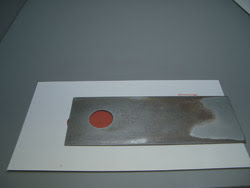
Figure 1. A metal spacer plate keeps the color-measuring instrument at a constant distance from the surface. Courtesy of X-Rite Ltd.
“The plate prevents contamination of the contact spectrophotometer when it is placed on the wet sample and is a much more cost-effective solution than using a noncontact spectro[photometer],” he said. “Although the optical path length will have varied by the introduction of the spacing plate, all measurements taken with this method will be comparable and repeatable.”
Lipstick presents a challenge because nonopacity or thickness variations lead to the loss of light through the back of the sample, while any ripples in the surface alter the angular reflection of the light and change the measurement results. One way to address this is to melt the lipstick, pour it into a mold and form a solid, opaque sample of uniform thickness, with a level front surface. An alternative method is to use a special holder to keep the lipstick at a carefully controlled angle relative to the instrument, ensuring measurement repeatability (Figure 2).
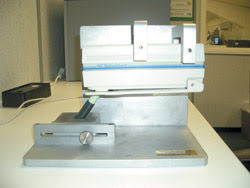
Figure 2. A custom holder presents a white lipstick sample at a carefully controlled angle (sample illuminated at 0°, reflectance measured at 45°) to a spectrophotometer held in a clamp. The instrument has a removable measurement optic cover, which enables easy cleaning. Courtesy of X-Rite Ltd.
Datacolor of Lawrenceville, N.J., also has customers in cosmetics. Greg Rohaus said that the company evaluates lipstick by applying it to a glass slide and measuring the color through the back of the slide.
‘No mess’
“With the glass slide method, the sample is opaque. The glass slide tends to not compromise the measured data, and there is no mess. The sample and slide are easily disposed,” he said.
Nail polish provides another difficult color-measurement task because of its translucency. It reflects some light and transmits some; therefore, its color is dependent on the background. X-Rite reports that customers measuring nail polish overcome the problem by applying a uniform thickness of varnish over an alternating black-and-white background. Over the black part, it is possible to measure the fraction of light reflected by the polish itself; over the white part, the transmitted light is returned to the measuring instrument. Using Kubelka-Munk color theory to calculate the absorption and scattering coefficients of the polish from these two sets of measurements, the technologist can calculate the color of an infinitely thick and perfectly opaque layer.
The pearl pigments in modern eye shadows and powders also confuse measurement equipment because the intensity and color of the reflected light have a strong angular dependency. X-Rite says that its customers’ color technicians prepare this material for measurement by using a standard force to press the powder into a pellet that fits the instrument. This produces a solid sample for easy handling and contact measurement, and the standardized presentation of the pearl pigments provides repeatable data.
In Datacolor’s preferred method, hydraulic presses push powders into a firm cake that can be presented to its Datacolor 600 benchtop reflectance spectrophotometer with little risk of powder falling into the 6-in. integrating sphere. Rohaus explained, “This is a very reproducible sample presentation method as long as a consistent amount of pressure is applied.”
The company says that, by using diffuse illumination so that the grains are lighted from all angles, and port sizes larger than 9 mm are used to include a large number of grains in the measurement, these instruments can average out the grainy nature of the samples and produce more repeatable results.
Similarly, Konica Minolta Sensing Inc. of Osaka, Japan, whose instruments are used in color quality control of the cosmetic products of Nottingham, UK-based Boots the Chemist, offers cosmetics-specific accessories for its CR-400 handheld Chroma Meter; one example is the granular materials attachment for powders, pastes and grains. The Chroma Meter provides diffuse illumination from a pulsed xenon light source and measures the color of the reflected light at a 0° viewing angle in just 1 s.
Testing hair dyes also creates a challenge, partly because dyed hair does not necessarily lie flat during measurement and is, by its fibrous nature, directional in its light-reflecting properties. In some recent tests on dye, Datacolor researchers developed a sample holder in which hair is made to lie evenly across a flat plate, stretched out to remove any curls and kinks, and held in place by a pair of bars.
Blocking the sun
Another cosmetic product that requires measurement is sunscreen, but, in this context, the tests concern not color, but effectiveness. Before a sunscreen can be marketed, it must be tested on people. According to guidelines from European and US regulators, a product must be applied to the skin of a volunteer and exposed to artificial sunlight (Figure 3). The rate of reddening of untreated skin compared with that of treated skin gives the sun protection factor (SPF).
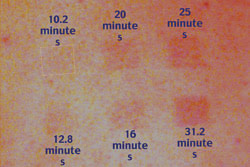
Figure 3. The in vivo testing of sunscreens involves application of samples to the skin of volunteer test subjects and subsequent exposure to artificial sunlight. Courtesy of Boots the Chemist.
For example, SPF 15 produces the same reddening in 15 h as that which occurs in untreated skin in 1 h. Until the 1980s, testing sunscreen on volunteers was the only available method for measuring sunblock, but since then, formulators, producers and independent test houses have started using photonics for initial assessments.
Labsphere Inc. of North Sutton, N.H., has a laboratory instrument to assist in this testing. Its UV transmittance analyzer (Figure 4) sends light from a UV-rich xenon flash source through the product and into an integrating sphere, then on to a diode array detector to measure the transmittance of UV radiation at various wavelengths simultaneously. The integrating sphere ensures that SPF the measurements are not overestimated because of the light-scattering of ingredients such as titanium dioxide. The speed of the measurement allows the user to average several sets of tests and thus reduce errors.
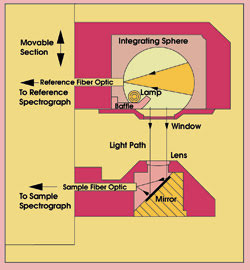
Figure 4. Labsphere’s UV analyzer, which measures the protection factor of sunscreens, has a spectral range of 250 to 450 nm and uses two photodiode array spectrographs to acquire complete spectra within 5 s. Courtesy of Labsphere Inc.
Robert Yeo of Pro-Lite Technology LLP, the Labsphere dealer in the UK, said that the primary challenge in developing this instrument was providing a sufficient signal-to-noise ratio for measurements of up to SPF 50, or 2 percent transmittance.
“Placing a lamp inside a sphere rather than using the sphere to collect the diffusely transmitted light gave us a gain in signal of some two orders of magnitude,” he said.
Sample preparation is critical to achieving repeatability and proper correlation between the instrumental measurement and the tests on human skin, and this is an area that presents further difficulties. The Food and Drug Administration recommends coverage of 2 mg/cm2 on a substrate that is transparent to UV radiation and that has a porosity and texture similar to human skin. The sunscreen is typically applied in small dots from a pipette, and the operator spreads the sample over the surface of the substrate with a finger. The thickness varies, and several samples must be measured to overcome the resulting variability in SPF value.
“In the early days of in vitro testing (circa 1990),” Yeo said, “3M’s Transpore tape was widely used, but in recent years, alternative materials have been developed which provide a closer match to the physics of human skin and allow the samples to be applied much more uniformly.”
Labsphere’s analysis software calculates sunscreen transmittance between 250 and 450 nm, as well as the mean UVA-to-UVB transmittance ratio. UVB is 280 to 315 nm and affects the outer layer of skin, causing sunburn; UVA is 315 to 400 nm and penetrates deeper. Both cause wrinkles by breaking down collagen and inhibiting the skin’s repair mechanism.
Salon photonics
As with other color-measurement applications, photonics for cosmetics and beauty applications is moving out of the quality control laboratory and closer to the consumer. Department stores in Japan, Korea, Taiwan and China use point-of-sale instrumentation to help sell cosmetic products.
Video microscope manufacturer Moritex Corp. of Tokyo has been making instruments for studying the appearance and condition of human skin and hair for about five years, and it has just started marketing them in the US and Europe. For example, the company’s i-Scope produces a magnified image of the skin, showing its texture and any clogged pores, and sends the image to a PC by means of a USB interface.
“Used professionally, the instruments back up the expertise of the skin-care expert or counselor and provide visual and numeric references for what is otherwise a verbal description of their observation,” said Alistair Gooch, sales and marketing manager at Moritex Europe Ltd. in Cambridge, UK. “The extra information is also educative and helps to give the customer extra assurance. This, in turn, leads to better long-term customer loyalty.”
The i-Scope is also useful for hair treatments because it can show the condition of the hair and scalp and, especially at higher magnifications, can provide a detailed analysis of hair cuticles and keratin cells. It uses a white LED light source for reliability, efficiency and low heat output, and a cost-effective 1/3-in. CMOS sensor with 640 × 480 pixels. The system has a range of lenses, which produce magnifications from 1× to 700×, and a 14-in. display.
Another Moritex instrument — the Triplesense TR-3 — simultaneously measures skin moisture, elasticity and oiliness and compares the results with the average for the client’s age group. The cordless handheld instrument can store data in a PC to track changes for individuals. The measurement head incorporates an optical system that uses the company’s refraction-based technique for measuring skin oil (sebum content), an electrical capacitance sensor for skin moisture and an ultrasonic-frequency vibration sensor that measures skin elasticity. The liquid crystal display indicates whether the skin condition is high, medium or low for each metric, and identifies the skin type as normal, oily, dry or oily-dry.
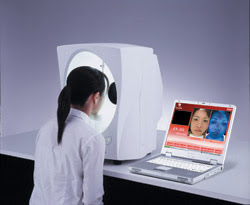
Figure 5. The DM3 Facial Stage captures full-color and UV images of the face, which enables dermal changes to be detected and tracked over time. Courtesy of Moritex Corp.
The company’s latest product in the field is the DM3 Facial Stage (Figure 5), which captures full-color and UV-based images of clients’ faces using a 5-megapixel digital camera and uniform lighting that has the same intensity on all occasions so that changes in the customer’s face can be detected and tracked over time. Based on the principle that different materials fluoresce at different wavelengths — for example, sebaceous oils show up as shades of yellow — the UV image reveals blocked pores and subdermal pigmentation. This technique also has applications in regard to such medical conditions as skin cancer.
Photons go skin deep
New instruments that measure skin pigments are proving useful in dermatology, physiology and pharmacology as well. They allow researchers to evaluate the effectiveness of therapies for skin lesions and are useful in monitoring exposure to UV radiation.
Dia-Stron Ltd. in Andover, UK, makes a device for research and clinical applications that measures changes in hemoglobin and melanin, the two main chromophores of the human skin. It illuminates the skin with bright tungsten-halogen light and measures the light reflected through narrow bandpass filters at wavelengths specific to the chromophores — in the red and green regions for erythema, and in the red and infrared for melanin. The instrument has a fiber optic probe and displays its measurements either on a liquid crystal graphics display or through a serial data port to a computer.
Taking a different approach to skin studies, Horiba Jobin Yvon Inc. of Edison, N.J., has designed a confocal Raman probe to combine the advantages of high spatial resolution and ease of handling.
Along with L’Oréal Research of Aulnay-sous-bois, France, the company is applying the Raman technique to study the chemical composition and structure of skin, hair and nail substrates. Their aim is to achieve a better understanding of the interactions between these substrates and cosmetic products to enable a better design of cosmetic ingredients. They see Raman spectroscopy as a key analytical technique because it enables a nondestructive and noninvasive molecular characterization of different substrates before and after treatment with cosmetics, and because it offers the advantage of allowing experiments in vivo.
In an initial pilot study, L’Oréal Research demonstrated the relevance of the confocal Raman probe for the investigation of the skin of human volunteers. The compact design and ease of use of the probe facilitated the measurements at various sites on the body, and its high spatial resolution enabled in-depth study of the layers of the skin. Results showed that it is possible to detect variations in the structure of the skin between different anatomical sites and between volunteers.
The probe also enables the determination of in vivo water concentration from the surface to several microns below the skin surface to assess its barrier properties and water-holding capacity. Using the probe, researchers also can monitor in vivo the penetration of cosmetic products, such as moisturizing cream, into the skin layers.